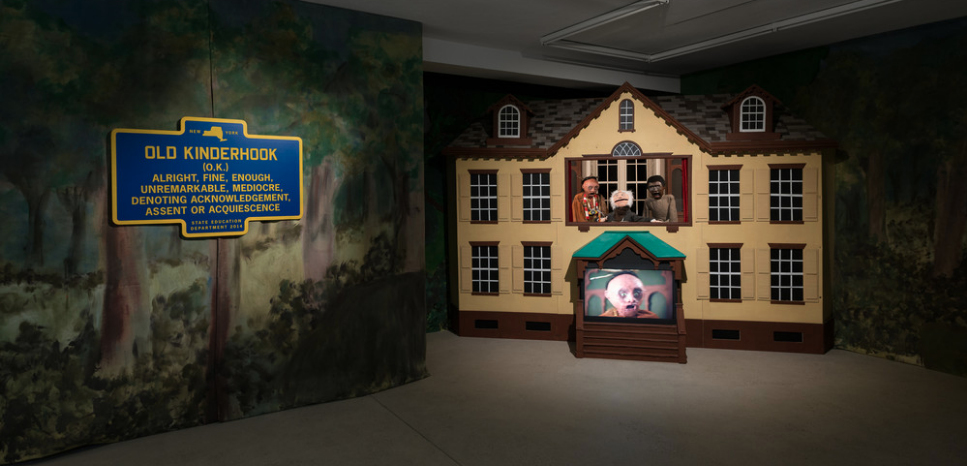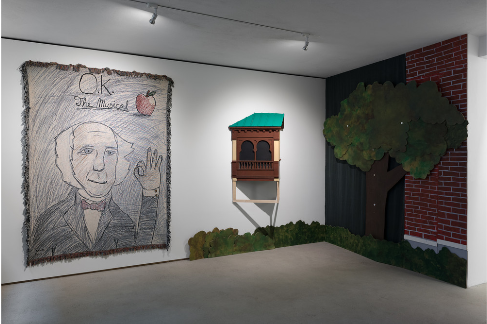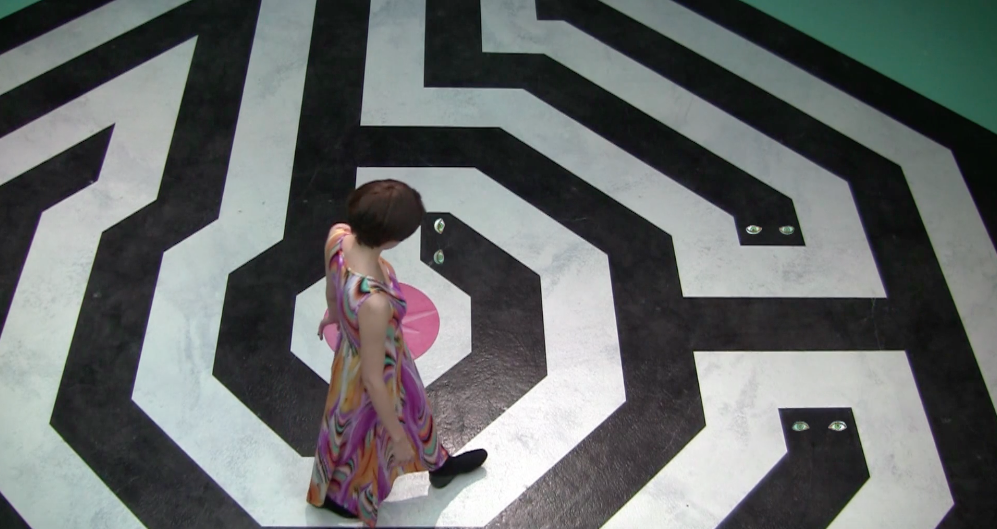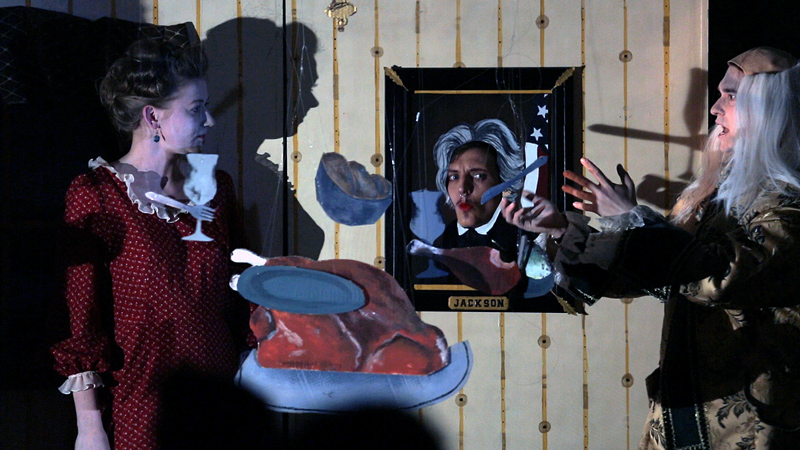Interview: Christopher Kline, An Artistry Fueled by Lore & History
Christopher Kline’s “O.K.” is an ongoing project that explores the history and lore of the artist’s hometown of Kinderhook, New York. In previous iterations, the project has been seen at KW Institute for Contemporary Art and Grimmuseum in Berlin as well as in Copenhagen at Arken Museum for Contemporary Art. “O.K. The Musical (The Many Ghosts of Martin Van Buren)” was recently on view at Wentrup in Berlin. The showcase combined installation, puppetry, video, and woven blankets to investigate the pitfalls of recorded history,
Kline is also co-founder, alongside his partner Sol Calero, of ‘Kinderhook and Caracas,’ a project space and initiative based in Berlin; its name referring to the founders’ origins in the USA and Venezuela.
Cultbytes catches up with the artist to chat about the exhibition and the other strands in his practice.
Sheena Malone: Kinderhook is your hometown, part of the name of your space in Berlin (Kinderhook & Caracas), and O.K. is an ongoing project based around the local history of Kinderhook. How important is place in relation to your practice. Why did you decide to begin working with your hometown?
Christopher Kline: I’ve lived away from Kinderhook for so long that it became a kind of surreal place in my head. I feel like the further you live from where you grew up, the more you wonder how the lens you see the world through was crafted. Why it’s a bit different, from other people you come across. In around 2013, as an artist I was tired of jumping around from topic to topic, and meanwhile it started to bother me the way that artists always explained their work as being “interested” in this or that. It kind of leads to a very superficial, Wikipedia kind of academic art-making. So, I wanted to really invest my time and thoughts in something special to me, also something that I know more about than most people. But it’s important to me that the project isn’t autobiographical or sentimental. Quite the opposite, as in some ways I’m using the history of Kinderhook and its sort of ‘dominant narrative’ as a case study, peeling it apart, really analyzing it. This kind of scrutiny is rarely afforded to such a small, seemingly inconsequential town, so it can really lead to a lot of interesting conversations and observations.
“Working with all ages and varieties of people has a very grounding effect…for artists who are a high-risk demographic for narcissism, this can be ground-breaking.”
-Kline
SM: Can you tell us a little about “O.K”?
CK: “O.K.” began as a sort of research, and as I was digging into it I was searching for aesthetic elements from Kinderhook to inform the way it manifested itself. I didn’t want to just impose my own aesthetics on a collective history. I was looking into crafts, architecture, nature, and all kinds of visual elements from the area. There isn’t really a predominant art form there, but there are several theaters in that part of the county that focus on musicals and the high school always does a musical. So, I started thinking about using the format of a community theater musical to embody the town’s history. At first it was very hypothetical. The great thing about a musical as a means of telling the history of a place is that it’s something that requires a lot of people, a lot of input and time and enthusiasm. You have to kind of conjure up the passion of a whole lot of personalities. While writing a book is usually a very solitary venture, for example. I liked the way it felt to do a musical as a history project, you feel like you’re not in it alone. Working with all ages and varieties of people has a very grounding effect. You become empathetic to the human condition, for artists who are a high-risk demographic for narcissism, this can be ground-breaking.
SM: Was “O.K.” initially devised as something that would develop in chapters over time or as a one-off project? Or once you scratched below the surface did you discover a treasure trove of material that yielded too much to incorporate into one project?
CK: I knew from the beginning that there was an infinite world there, so for the first “O.K.” exhibition I tried to cover as much ground and as many topics as possible, to sort of lay the groundwork. I didn’t want it to be just a “Headless Horseman” project or a show about Martin Van Buren, the 8th US President. So, I began by casting quite a wide net, and as I’ve moved along it just keeps going deeper and deeper. I was back in Kinderhook recently for the first time in two years, which is quite a while considering most of my work revolves around it. I came across a lot of stories I had no idea about. Things that fell through the cracks or that people wanted to forget. For example, many residents didn’t know that there used to be a large black population well into the 20th century who had their own church, their own community. They disappeared from the area rather quickly, apparently, and some signs point to that they were intimidated into fleeing. But that’s quite hard to prove at this point since there’s almost no documentation or even church records to go from.
 First image and this image. Christopher Kline, “The Many Ghosts of Martin Van Buren,” installation view, WNTRP, Berlin, 2016. Photo by Trevor Good.
First image and this image. Christopher Kline, “The Many Ghosts of Martin Van Buren,” installation view, WNTRP, Berlin, 2016. Photo by Trevor Good.
SM: At one point during your video piece “The O.K. Show (Episode 1: The Many Ghosts of Martin Van Buren)” Martin van Buren, while writing his memoirs, is visited by two ghosts, Joseph Cinqué who led the Amistad Slave Revolt and a Cherokee who would have endured the Trail of Tears. He responds to their accusations by stating “history is written by those in the land of the living and those with written languages.” When working with this historical material, how do you approach it?
CK: When dealing with very local histories, histories that are written from within, it’s especially easy to read between the lines. The element of subjectivity is glaring, so in many ways there is almost no distinction between fact, hearsay, and myth or folklore. The definitive history book of Kinderhook, published in 1914, is full of opinions and conjectures and some things which are patently false. So, whether it’s a history book or a book of ghost stories, if it’s from Kinderhook it’s probably “based on” a true story.
In a way, all history and facts go through a human filter and most get tangled up in the process with our tendency to tell stories, to create narratives, to notice coincidences, to make connections which may or may not be there. I take historical material with a grain of salt, especially since history is “written by the winners”, as they say. While I try to stay true to what’s been put out there, I’m making a slow effort to dig deeper and in between things, and also not to be beholden to ideologies of the past, present or future, which is probably impossible.
Poster design by elementary school student Emma Brusie. Christopher Kline, “The Many Ghosts of Martin Van Buren,” installation view, WNTRP, Berlin, 2016. Photo by Trevor Good..
SM: You also work with elementary school children whose teachers are responding to a set national curriculum. How do teachers view your approach?
CK: I haven’t had the opportunity to work directly with students in the US yet, where the issue of a national curriculum is a bit more contentious. So far it’s only been through remotely asking them to research elements of local history and design posters for the musical which I then turn into woven blankets. I’m trying to sell the blankets as an artist edition, and then all of the proceeds are donated in the name of the student artist who made the original drawing to a food pantry which feeds hungry children from the community. So teachers really like these kinds of elements of the project.
But since I’ve only done iterations of the musical in Europe I haven’t had to deal head-on with any questioning by the school systems into my methodology.
SM: Last year, Kinderhook & Caracas launched CONGLOMERATE TV, a collaborative Gesamtkunstwerk in the form of a tv network which includes commercials, gameshows, telenovela and other tv formats. Can you please tell us a little about how the project came about, the motivation and the people behind it?
CK: CONGLOMERATE is made up of a team of myself and four other artists, Sol Calero, Ethan Hayes-Chute, Derek Howard and Dafna Maimon. Initially Sol had come up with the idea of turning our space into a TV station for a year. Once we involved the others the idea became much more complex and developed and we also named it together. We each make our own shows and also curate “Blocks” mixed with other artist’s original videos. Part of the idea was that for those of us making immersive installations all of the time, we wanted to find new ways for the audience to experience it. Since so many people view exhibitions via a computer screen we thought, why not remove the mediation of a photographer, and make the screen the primary source. We also liked the way that skills are shared and credited in TV and film, and wanted to work with that model within art.
Still from “Block Two,” Conglomerate (2016), video, 35:24 mins. Photo courtesy Congolomerate.tv
SM: Last September, you released the Block Two, a video work. I’m looking forward to more DIY tips and the fate of Amazonas in Desde el Jardín. Are there any more blocks in the pipeline?
CK: We’ll be releasing a “Fragmented” Block Three in the coming months, sort of a block that trickles out one video at a time. Then Blocks four, five and six will come out in spring, summer and fall with a lot of exciting new content. There will also be a big new element which involves exhibitions both by and curated by CONGLOMERATE in which TV shows are shot. We’re doing three in Berlin and several abroad. In December, we did a massive project in The Hague at 1646 where we built an extensive set and filmed a “family drama” within it called “Oedipusmas”. It’ll be released later this year in its entirety as a “special”.
“O.K. – The Musical,” Dress Rehearsal, insitu and dem Netzwerk freier Berliner Projekträume und -initiativen, KW Institute for Contemporary Art, Berlin. Photo courtesy of the artist.
SM: CONGLOMERATE TV involves many artists, O.K. includes banners designed by pupils from the Ichabod Crane Elementary school in Kinderhook and your practice in general involves cooperation with others e.g. set designer, singers. There seems to be a substantial element of collaboration in your practice. Is the creation of a community around or within your practice important? Is this a conscious desire on your part?
CK: I’ve always enjoyed working in groups. Despite how frustrating it can often be, there’s always a huge reward. I enjoy collaborating with other artists, but even more so I like working with ordinary people who might approach creating and making with a different sense of wonder and doubt, and when it goes well it can be really life-changing for some people. I’m not sure I’ve ever really managed to create an actual ‘community’ through my practice, but hopefully I’ve added to some existing communities and things will keep growing as people find things that bind them together.
“O.K. – The Musical,” Dress Rehearsal, insitu and dem Netzwerk freier Berliner Projekträume und -initiativen, KW Institute for Contemporary Art, Berlin. Photo courtesy of the artist.
SM: Perhaps it is something to do with a breaking down of boundaries and power structures? I see parallels with the Historic Markers which once needed to be approved by the U.S. Education Department and SED and which is referenced in the work “New York State Historical Marker (O.K.)” But now local knowledge and be noted, marked and disseminated at grass roots level.
CK: Some people in the world are gifted in certain disciplines, but it’s important to remember that everyone who’s ever existed is just a person like you. Some have more insight than others, more awareness, more power, more focus, but in the end, all of our opinions can have resonance and legitimacy. Not to say that other people want or need to hear everyone else’s opinions. But it’s interesting to see what happens when you turn the tables, when you put a microphone to a side of the story that doesn’t usually hold it. The wisdom you’ll find there is often surprising. At the same time, today’s freedom of information can be very troubling and dangerous. Regarding the historical markers, I’d actually say it was slightly better when they had to be approved by the state because since then people often make them for totally opportunistic reasons (to increase property value, for example). We also see this freedom abused on social media and all of the horrible comments that have been posted across the internet over the past ten years. So, we’ve got to cultivate, we’ve got to engage all kinds of people in real-life dialog, in real-life activity, in meaningful exchange. Not that all of the world’s problems will be fixed, but at least people have to start meeting their neighbors again.
SM: What are your plans for the future?
CK: In the near-future I’m doing a large-scale version of “O.K.–The Musical” at Tate Liverpool in April with residents from Lancashire and Liverpool. So, that’s already been very exciting and thought-provoking, even though we’re still in the planning phase. I’ll be working with a lot of great people from all walks of life, so to speak. CONGLOMERATE has a lot going on as well, as I mentioned. Sol and I will also be doing a residency in Mexico City this fall which will be a nice extended break from Europe.
For the long-term future, we still have our sights set on running some kind of Kinderhook & Caracas residency program in Tenerife, living there part time, and having kids.
SM: Thank you for your time Christopher!
What's Your Reaction?
Writer, Cultbytes Curator and writer based in Berlin. Having worked for 6 years at The Douglas Hyde Gallery in Dublin, she moved to Sweden in 2011 to undertake an MA in curating contemporary art at Stockholm University. In 2015, she formed part of CuratorLab at Konstfack Stockholm where she investigated the folklore and local history of her hometown in Kildare, Ireland. She is also initiator and curator of Couchsurfers Paradise, a series of exhibitions unfolding in the homes of strangers. Additional recent projects have included Ritual Play, Verkstad Konsthall, Norrköping, and Faraway Longings, Irish Embassy Berlin. During the 2017 exhibition season, she will act as director of Dada Post, a project space in Berlin. l i-gram l






